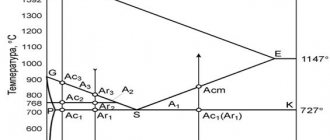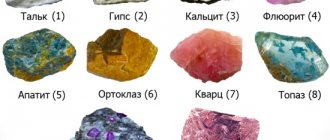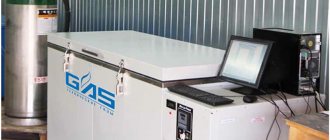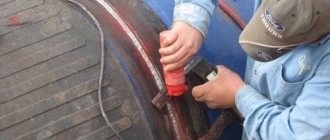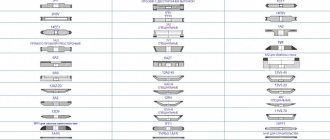Rockwell method
Among all existing methods for determining the hardness of steels and non-ferrous metals, the most common and most accurate is the Rockwell method.
Rockwell method - determination of metal hardness
Carrying out measurements and determining the Rockwell hardness number is regulated by the relevant documents of GOST 9013-59
. This method is implemented by pressing indenters—a diamond cone or a carbide ball—into the material being tested. Diamond indenters are used for testing hardened steels and carbide alloys, while carbide balls are used for testing less hard and relatively soft metals. Measurements are carried out using mechanical or electronic hardness testers.
The Rockwell method provides for the possibility of using a number of hardness scales A, B, C, D, E, F, G, H (54 in total), each of which provides the greatest accuracy only in its own relatively narrow measurement range.
To measure high hardness values with a diamond cone, the “A” and “C” scales are most often used. They are used to test samples made of hardened tool steels and other hard steel alloys. And comparatively softer materials, such as aluminum, copper, brass, and annealed steel are tested with ball indenters on the “B” scale.
Example of Rockwell hardness designation: 58 HRC or 42 HRB.
The numbers in front indicate a number or a conventional unit of measurement. The two letters after them are the Rockwell hardness symbol, the third letter is the scale on which the tests were carried out.
(!)
Two identical values from different scales are not the same thing, for example, 58 HRC ≠ 58 HRA. Rockwell numerical values can only be compared if they belong to the same scale.
Rockwell scale ranges according to GOST 8.064-94:
| A | 70-93 HR |
| B | 25-100 HR |
| C | 20-67 HR |
Locksmith tool
Tools for manual metal processing (chopping, cutting, filing, branding, punching, marking) are made from carbon and alloy tool steels. Their working parts are subjected to hardening to a certain hardness, which should be within the following limits:
| Hacksaw blades, files | 58 – 64 HRC |
| Chisels, crosspieces, bits, center punches, scribers | 54 – 60 HRC |
| Hammers (head, toe) | 50 – 57 HRC |
Installation tool
This includes various wrenches, screwdrivers, and pliers. The hardness standard for their working parts is set by current standards. This is a very important indicator, which determines how wear-resistant the tool is and can resist crushing. Sufficient values for some instruments are given below:
| Wrenches with jaw size up to 36 mm | 45.5 – 51.5 HRC |
| Wrenches with jaw size from 36 mm | 40.5 – 46.5 HRC |
| Phillips, slotted screwdrivers | 47 – 52 HRC |
| Pliers, pliers, duckbills | 44 – 50 HRC |
| Nippers, side cutters, metal scissors | 56 – 61 HRC |
Metal cutting tool
This category includes consumable equipment for metal cutting, used on machine tools or with hand tools. For its manufacture, high-speed steels or hard alloys are used, which retain hardness in cold and overheated states.
| Taps, dies | 61 – 64 HRC |
| Countersinks, countersinks, counterbores | 61 – 65 HRC |
| Metal drills | 63 – 69 HRC |
| Titanium nitride coated drills | up to 80 HRC |
| HSS cutters | 62 – 66 HRC |
Note:
Some milling cutter manufacturers indicate in the marking the hardness not of the cutter itself, but of the material that it can process.
Fasteners
There is a relationship between the strength class of a fastener and its hardness. For high-strength bolts, screws, and nuts, this relationship is reflected in the table:
| Bolts and screws | Nuts | Washers | ||||||||||||||
| Strength classes | 8.8 | 10.9 | 12.9 | 8 | 10 | 12 | Art. | Zak.art. | ||||||||
| d<16 mm | d>16 mm | d<16 mm | d>16 mm | |||||||||||||
| Rockwell hardness, HRC | min | 23 | 23 | 32 | 39 | 11 | 19 | 26 | 29.2 | 20.3 | 28.5 | |||||
| max | 34 | 34 | 39 | 44 | 30 | 36 | 36 | 36 | 23.1 | 40.8 | ||||||
If for bolts and nuts the main mechanical characteristic is the strength class, then for such fasteners as lock nuts, washers, set screws, hardness is no less important.
The following minimum/maximum Rockwell values are established by the standards:
| Retaining rings up to Ø 38 mm | 47 – 52 HRC |
| Retaining rings Ø 38 -200 mm | 44 – 49 HRC |
| Retaining rings from Ø 200 mm | 41 – 46 HRC |
| Lock toothed washers | 43.5 – 47.5 HRB |
| Spring steel washers (grover) | 41.5 – 51 HRC |
| Bronze spring washers (grover) | 90 HRB |
| Set screws of strength class 14H and 22H | 75 – 105 HRB |
| Set screws of strength class 33H and 45H | 33 – 53 HRC |
Converting hardness units hb to hrc
Conversion table H B – HRC (Hardness Conversion)
(ratio of Brinell hardness to Rockwell hardness, determined by methods in accordance with GOST 8.064-79)
Hardness is the resistance of a body to the penetration of an indenter - another solid body. Hardness testing methods are divided into static and dynamic.
Static methods include methods for measuring hardness according to Brinell, Vickers, Rockwell, Knoop; to dynamic - methods of measuring hardness according to Shore, Schwartz, Bauman, Poldi, Morin, Grave.
Hardness measurements are carried out at 20±10°C.
Brinell hardness measurement
Brinell method
Brinell method [named after the Swedish engineer J.A. Brinell] – a method of determining the hardness of materials by pressing a hardened steel ball with a diameter of 2.5 into the test surface; 5 and 10 mm with load P from 625 N to 30 kN. Brinell hardness number HB is the ratio of load (kgf) to the area (mm 2 ) of the print surface. To obtain comparable results of relative hardness, materials (HB over 130) are tested at a ratio P:D 2 = 30, materials of medium hardness (HB 30-130) - at P: D 2 = 10, soft (HB 2 = 2.5. Tests according to the Brinell method, they are carried out on stationary hardness testers - Brinell presses , which ensure smooth application of a given load to the ball and its constancy when held for a set time (usually 30 seconds).
The Brinell method for measuring the hardness of metals is regulated by GOST 9012-59 “ Metals. Brinell hardness method : The standard establishes a method for measuring the Brinell hardness of metals with a hardness of not more than 650 units. The essence of the method is to press a ball (steel or hard alloy) into a sample (product) under the influence of a force applied perpendicular to the surface of the sample for a certain time, and measure the diameter of the indent after removing the force. GOST 9012-59, in particular, defines the requirements for the selection of metal samples for measuring Brinell hardness - sample size, surface roughness, etc.
Rockwell hardness measurement
material provided by SIDOROV Alexander Vladimirovich
Hardness
– the property of a material to resist the penetration of another, harder body into it – an indenter.
There are several scales (measurement methods) for measuring hardness, the most common of which are [1]:
- Brinell method
(HB) - hardness is determined by the diameter of the imprint left by a metal ball pressed into the surface. Hardness is calculated as the ratio of the force applied to the ball to the area of the indentation. The dimension of Brinell hardness units is MPa. The method is not applicable to thin materials and materials with high hardness; - Rockwell method
(HRA, HRB, HRC) - hardness is determined by the relative depth of indentation of a metal ball or diamond cone into the surface of the material being tested.
Hardness is calculated using the formula [2]: HR = HRmax – (H – h) / 0.002
, where
HRmax
is the maximum Rockwell hardness (on scales A and C it is 100 units, and on scale B – 130 units),
(H – h )
is the difference between the indenter immersion depths (in millimeters) after removing the main load and before its application (with pre-loading). Hardness determined by this method is a dimensionless quantity. The Rockwell method is easier to implement, but has less accuracy compared to the Brinell and Vickers methods. Testing of samples with a thickness less than ten times the tip penetration depth is not permitted; - Vickers method
(HV) - hardness is determined by the area of the imprint left by a tetrahedral diamond pyramid pressed into the surface. Hardness is calculated as the ratio of the load applied to the pyramid to the area of the indentation. The dimension of Vickers hardness units is MPa. Allows you to determine the hardness of nitrided and cemented surfaces, as well as thin sheet materials [3]:, but has reduced accuracy in the lower range (for soft materials).
Read also: How to reduce the speed of an electric motor using pulleys
The results of hardness measurements using the Rockwell and Vickers methods can be converted using tables into hardness units using the Brinell method (Table 1) [4]. Knowing the Brinell hardness, it is possible to calculate the tensile strength and yield of the material, which is important for applied engineering problems [5]:
for aluminum alloys:
for copper alloys:
where σв
– ultimate strength, MPa;
σт
– yield strength, MPa.
Table 1 – Translation of hardness measurement results
| Brinell scale, HB | Rockwell scale, HRB (HRC) | Vickers scale, HV |
| 100 | 52,4 | 100 |
| 105 | 57,5 | 105 |
| 110 | 60,9 | 110 |
| 115 | 64,1 | 115 |
| 120 | 67,0 | 120 |
| 125 | 69,8 | 125 |
| 130 | 72,4 | 130 |
| 135 | 74,7 | 135 |
| 140 | 76,6 | 140 |
| 145 | 78,3 | 145 |
| 150 | 79,9 | 150 |
| 155 | 81,4 | 155 |
| 160 | 82,8 | 160 |
| 165 | 84,2 | 165 |
| 170 | 85,6 | 170 |
| 175 | 87,0 | 175 |
| 180 | 88,3 | 180 |
| 185 | 89,5 | 185 |
| 190 | 90,6 | 190 |
| 195 | 91,7 | 195 |
| 200 | 92,8 | 200 |
| 205 | 93,8 | 205 |
| 210 | 94,8 | 210 |
| 215 | 95,7 | 215 |
| 220 | 96,6 | 220 |
| 225 | 97,5 | 225 |
| 230 | 98,4 | 230 |
| 235 | 99,2 | 235 |
| 240 | 100,0 | 240 |
| 245 | (21,2) | 245 |
| 250 | (22,1) | 250 |
| 255 | (23,0) | 255 |
| 260 | (23,9) | 260 |
| 265 | (24,8) | 265 |
| 270 | (25,6) | 270 |
| 275 | (26,4) | 275 |
| 280 | (27,2) | 280 |
| 285 | (28,0) | 285 |
| 290 | (28,8) | 290 |
| 295 | (29,5) | 295 |
| 300 | (30,2) | 300 |
| 310 | (31,6) | 310 |
| 319 | (33,0) | 320 |
| 328 | (34,2) | 330 |
| 336 | (35,3) | 340 |
| 344 | (36,3) | 350 |
| 352 | (37,2) | 360 |
| 360 | (38,1) | 370 |
| 368 | (38,9) | 380 |
| 376 | (39,7) | 390 |
| 384 | (40,5) | 400 |
| 392 | (41,3) | 410 |
| 400 | (42,1) | 420 |
| 408 | (42,9) | 430 |
| 416 | (43,7) | 440 |
| 425 | (44,5) | 450 |
| 434 | (45,3) | 460 |
| 443 | (46,1) | 470 |
| (47,5) | 490 | |
| (48,2) | 500 | |
| (49,6) | 520 | |
| (50,8) | 540 | |
| (52,0) | 560 | |
| (53,1) | 580 | |
| (54,2) | 600 | |
| (55,4) | 620 | |
| (56,5) | 640 | |
| (57,5) | 660 | |
| (58,4) | 680 | |
| (59,3) | 700 | |
| (60,2) | 720 | |
| (61,1) | 740 | |
| (62,0) | 760 | |
| (62,8) | 780 | |
| (63,6) | 800 | |
| (64,3) | 820 | |
| (65,1) | 840 | |
| (65,8) | 860 | |
| (66,4) | 880 | |
| (67,0) | 900 | |
| (69,0) | 1114 | |
| (72,0) | 1220 |
Read also: How to check an electrical circuit
Conversion of hardness values should only be used in cases where it is impossible to test the material under the specified conditions. The resulting hardness conversion numbers are only approximate and may not be accurate for specific cases. Strictly speaking, such a comparison of hardness numbers obtained by different methods and having different dimensions is devoid of any physical meaning, but, nevertheless, has a definite practical value.
| Rockwell | Brinell | Vicker s | Shore | To break | ||
| HRA | H.R.C. | HB(3000H) | Print diameter, mm | H.V. | HSD | N/mm² |
| 89 | 72 | 782 | 2.20 | 1220 | ||
| 86.5 | 70 | 1076 | 101 | |||
| 86 | 69 | 744 | 2.25 | 1004 | 99 | |
| 85.5 | 68 | 942 | 97 | |||
| 85 | 67 | 713 | 2.30 | 894 | 95 | |
| 84.5 | 66 | 854 | 92 | |||
| 84 | 65 | 683 | 2.35 | 820 | 91 | |
| 83.5 | 64 | 789 | 88 | |||
| 83 | 63 | 652 | 2.40 | 763 | 87 | |
| 82.5 | 62 | 739 | 85 | |||
| 81.5 | 61 | 627 | 2.45 | 715 | 83 | |
| 81 | 60 | 695 | 81 | 2206 | ||
| 80.5 | 59 | 600 | 2.50 | 675 | 80 | 2137 |
| 80 | 58 | 2.55 | 655 | 78 | 2069 | |
| 79.5 | 57 | 578 | 636 | 76 | 2000 | |
| 79 | 56 | 2.60 | 617 | 75 | 1944 | |
| 78.5 | 55 | 555 | 598 | 74 | 1889 | |
| 78 | 54 | 2.65 | 580 | 72 | 1834 | |
| 77.5 | 53 | 532 | 562 | 71 | 1772 | |
| 77 | 52 | 512 | 2.70 | 545 | 69 | 1689 |
| 76.5 | 51 | 495 | 2.75 | 528 | 68 | 1648 |
| 76 | 50 | 513 | 67 | 1607 | ||
| 75.5 | 49 | 477 | 2.80 | 498 | 66 | 1565 |
| 74.5 | 48 | 460 | 2.85 | 485 | 64 | 1524 |
| 74 | 47 | 448 | 2.89 | 471 | 63 | 1496 |
| 73.5 | 46 | 437 | 2.92 | 458 | 62 | 1462 |
| 73 | 45 | 426 | 2.96 | 446 | 60 | 1420 |
| 72.5 | 44 | 415 | 3.00 | 435 | 58 | 1379 |
| 71.5 | 42 | 393 | 3.08 | 413 | 56 | 1317 |
| 70.5 | 40 | 372 | 3.16 | 393 | 54 | 1255 |
| 38 | 352 | 3.25 | 373 | 51 | 1193 | |
| 36 | 332 | 3.34 | 353 | 49 | 1138 | |
| 34 | 313 | 3.44 | 334 | 47 | 1076 | |
| 32 | 297 | 3.53 | 317 | 44 | 1014 | |
| 30 | 283 | 3.61 | 301 | 42 | 965 | |
| 28 | 270 | 3.69 | 285 | 41 | 917 | |
| 26 | 260 | 3.76 | 271 | 39 | 869 | |
| 24 | 250 | 3.83 | 257 | 37 | 834 | |
| 22 | 240 | 3.91 | 246 | 35 | 793 | |
| 20 | 230 | 3.99 | 236 | 34 | 752 | |
Read also: Universal template 00316
Rockwell hardness
Indentation of a diamond cone with an angle of 120° at the apex and measurement of the relative depth of immersion into the material under study.
Scale A – load 60 kgf, for tungsten carbide (VK)
Scale C – load 150 kgf, for hard steel HRB>100
The advantage is simplicity. Disadvantage: low accuracy.
Brinell hardness
The diameter of the imprint of a metal ball in the material.
Disadvantage: hardness up to 450HB.
Vickers hardness
The area of the imprint from a diamond pyramid.
Shore hardness
Rebound of a ball from a surface in a scleroscope (rebound method). A very simple and convenient method.
Determining the hardness of a material is an important part of the technological process for manufacturing parts of any complexity.
Various methods for searching for the hardness of a metal are primarily associated with the difference in their structure and shape. Working with a regular blank in the form of a blank is not difficult, but sheet material requires a special approach, given its small thickness.
Only using the Vickers method is it most convenient to search for the hardness of nitrided and cemented surfaces.
Calculation of the service life of a metal-cutting tool, its durability, is always carried out primarily taking into account tabular indicators.
It is thanks to the increased hardness (about 71 HRC) that carbide drills and cutters made from VK8 alloy make it possible to process super-hard materials.
Relative hardness measurement using files
The cost of stationary and portable hardness testers is quite high, so their purchase is justified only by the need for frequent use. Many craftsmen, if necessary, practice measuring the hardness of metals and alloys relatively, using improvised means.
Measuring hardness using files
Filing a sample with a file is one of the most accessible, but far from the most objective, ways of checking the hardness of steel parts, tools, and equipment. The file must have a non-blunted double cut of medium size No. 3 or No. 4. The resistance to filing and the accompanying grinding noise makes it possible, even with little skill, to distinguish unhardened steel from moderately (40 HRC) or hard-hardened (55 HRC).
For testing with greater accuracy, there are sets of calibrated files, also called scratch hardness testers. They are used for testing saw teeth, milling cutters, and gears. Each such file carries a certain value on the Rockwell scale. Hardness is measured by briefly scratching the metal surface alternately with files from the kit. Then two close ones are selected - a harder one, which left a scratch, and a less hard one, which could not scratch the surface. The hardness of the metal being tested will be between the hardness values of these two files.
Why are hardness tables needed?
However, let's return to the question posed: why do we need hardness tables?
In short, they are indispensable if different methods of hardness measurement are used. You can understand what we are talking about using specific examples.
Example: how to measure the hardness of a 65G steel wavy spring
You need to measure the hardness of a 65G steel wavy spring, but it is very thin, less than 0.5 mm thick, and cannot be tested with a conventional Rockwell apparatus at a load of 150 kgf or 60 kgf, since it will sag. However, the final values must be obtained from HRC. You can get out of this situation if you use a Super-Rockwell apparatus, for example, at a load of 15 kgf (HR15N), in which case you will receive the correct hardness values, which you can convert into the required units using the table.
Example: how to determine the hardness of beryllium bronze BrB2
Or the following example. It is necessary to determine the hardness of beryllium bronze BrB2; after dispersion aging it should be at least 320 HV (Vickers). You can also “prick” it on a Super-Rockwell machine, and then convert the resulting values, for example, in HR15N to HV.
Brinell method
When determining the hardness of non-ferrous metals, the Brinell method is used, which consists of pressing a metal ball into the surface of the part, then measuring the diameter of the indentation and converting the values to HB (see Table No. 2). To carry out the described manipulation, you need a special apparatus, but in the absence of it, you can use the same good old Rockwell (“Ball” indenter, load 100 kgf). This way you can control soft metals: aluminum, copper, brass, bronze.
Modern hardness testers have an advanced interface and can connect to a computer and convert hardness values from one method to another automatically. Such equipment is convenient to use and does not require highly qualified operator, but its cost is not always affordable. There are also complaints about ultrasonic hardness testers regarding measurement accuracy. You come to the conclusion that the old, proven over the years, is better than the dubious new at exorbitant prices. If you need to precisely control the hardness after heat treatment, purchase a Soviet-style Rockwell thermal machine; they are made of very high quality and their resource is almost unlimited. This Rockwell will provide precision and breadth of measurements. A cheaper option (but fail-safe) is to determine hardness using a set of calibrated files, although that's a completely different story.
Vickers method
The Vickers method is characterized by low loads and, unlike other methods, where sometimes rough grinding on a sandpaper or a grinding and grinding machine is sufficient, it requires ideal preparation of the surface under study (to a mirror state). Hardness is determined by the diagonal of the indentation (pyramid), which is also converted to HV according to the table. No. 1. Vickers is indispensable when studying the results of chemical-thermal treatment. For example, the hardness of a nitrided layer, if it has a shallow depth, can only be determined by Vickers; Super-Rockwell will show incorrect results in such a situation.

